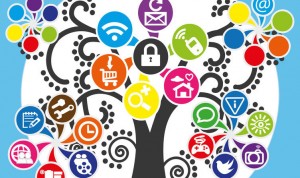Business has changed a lot in the last few decades—so much so, that it sometimes feels funny to draw comparisons between the 1980s and 2018. You might wonder how people ever got anything done, especially when you look at how weak technology was back then. It was the beginning of a major shift in business and technology, with people beginning to understand what computers could do. Here are some major ways technology has changed between then and now.
Computing Power
Can you imagine working without a computer? Even the most labor-oriented jobs now require at least minimal technological assistance, when only a few decades ago, many jobs were done with little or no technology. Manual work was the norm—with paper and pen, manual communication and little reliance on databases.
Not only that, but the computing power of 30 years ago was severely limited. No wonder people were in such a hurry to pick up Apple’s first consumer computer in 1984. Its biggest selling point was a massive 128KB of RAM, along with a pre-installed floppy disk drive and a few graphic design programs. Today’s typical computers boast a whopping 64 times that amount of RAM as well as solid state drives that make those floppy disks look truly ancient with their glacial read and write speeds.
This comparatively massive computing power has paved the way for the proliferation of massive databases that have made both government and business operations infinitely more efficient. At the same time, hardware manufacturers have been able to miniaturize memory and microprocessors to the point that today’s smartphones vastly outclass even desktop computers from 20 years ago.
Faxing
If you could sum up business and technology in the 1980s with one machine, it would definitely be the fax machine. Slow and clunky even by the standards of the day, early fax machines spit out barely legible prints that were hard to read and slow to print, making them a nightmare of inconsistent performance. Even though fax machines are still used today and have made a huge jump in terms of legibility and speed, they still are not considered to be highly innovative or impressive.
However, services such as eFax now allow for secure sending and receiving of faxes without the need for a fax machine. It’s just like emailing or messaging, and you can do it from a computer, tablet or smartphone. This system enables businesses to retain faxing as an official communications option while utilizing the internet to make it more convenient and secure.
Mobility
In the late 1980s, a laptop computer was a massive beast that would be supremely uncomfortable if you actually tried to sit it on your lap. Now with the advent of tablets and phablets, you can literally hold several hundred times the computing power of those leading-edge laptops in the palm of your hand.
This in conjunction with the internet, satellites and ubiquitous cellular networks has made it possible for anyone whose job revolves around computers to get their work done from almost anywhere in the world. Online faxing means they don’t need to run to the office or stay home to receive that critical fax; it can be sent to them securely wherever they happen to be at the moment. Though this ability to work from anywhere has led to a debate around whether employees are being overworked to the point that productivity is being lost, there can be no doubt that it has revolutionized the way the modern office or tech worker is able to do their job.
Collaboration
To say that team collaboration didn’t exist in the 1980s or earlier would be a lie, but it certainly isn’t as refined as it is now. In the past, teams and departments would have to meet face to face, or at best rely on phone conversations or very slow emails.
Today, departments can digitally collaborate on the same projects simultaneously, allowing several employees to create, modify and even present projects without ever having to meet in the flesh. Real-time video conferencing allows for face-to-face meetings with participants scattered across the globe. We’re talking about tools like Skype and Slack.
Thirty years ago, this was the stuff of science-fiction television; now it’s simply another tool in the productivity toolbox of the 21st century.
Conclusion
It’s mind-boggling how much technology has changed business in just the last few decades. It’s become so simple to take the office with you that some companies are finding themselves telling their employees to shut off their smartphones and stay away from their laptops while they’re on vacation. While they’re on the clock, the location-neutral paradigm allows anyone to work from wherever they wish without losing productivity. Whether it’s a video, email or fax, the ubiquitous availability of near-instant communication has forever changed the means of doing business in America and around the world.
Business & Finance Articles on Business 2 Community(56)
Report Post




